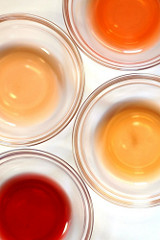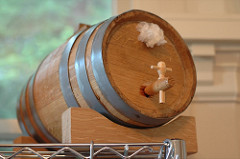Old Wine Gone Good

So much for a blind tasting
Photo by Melissa Schneider.
I have discovered an incredible red wine vinegar. Other vinegars in our pantry have a thin, orange color. This one is a deep red-violet. Other vinegars have faint floral or fruit notes. This one tastes like wine, fruity and complex. (Tasting notes to come.) This vinegar makes you wonder if the others are actually the same substance.
I'll tell you the name when I decide on one.
Ed Behr inspired me to make my own vinegar when he eloquently described the process in issue 68 of The Art of Eating. Ed doesn't use David Rosengarten-esque hyperbole, so the piece's title caught my eye: "The Best Red-Wine Vinegar You're Likely to Find Is the One You Make Yourself." When he followed that title with "you probably don't know how good red wine vinegar can be," I resolved to find out.
Homemade vinegar has automatic advantages even over the bottles you'll find in gourmet food shops. I use good wine (leftovers from tastings or, more rarely, dinner). Most companies use cheap base wine. I don't filter or pasteurize my vinegar. Commercial outfits have to go through these flavor-destroying steps. Want to have your own vinegar epiphany? Here are my thoughts after seven or eight months of experimentation. If you're serious about creating a red wine vinegar unlike any you've ever tasted, contact AoE and get a copy of that issue (and tell them I sent you, though they might think you want to read the foie gras piece I wrote for that issue).
Two Ways to Start
In theory, you can make vinegar by leaving wine in an open jar for a while. In practice, I find vinegar au naturel a risky proposition. I tried it and ended up with a flat-smelling liquid and some fuzzy, white blobs floating on the surface. You might have better luck with a low-sulfite wine. Sulfites protect wine against Acetobacter, the microorganism that eats alcohol and converts it to the same amount of acetic acid. (Since white wine tends to have more sulfites, it's harder to make white wine vinegar).
For best results, find some "mother," an active, healthy culture of bacteria. Often it will have "scum" on the surface, which is nothing more than cellulose. I found my mother at Oak Barrel, a top-notch Berkeley store that caters to wine/beer/vinegar makers. Order from them if you can't find a local source. Mix the culture with some wine, sit back, and wait for two weeks to two months. Start with a 1:1 mother:wine ratio, and then increase the wine as your culture becomes stronger. My current batch is roughly 1:4, and the transformation seems to be progressing faster than either of my previous batches. The warmer weather might be contributing to the increased speed.
Regardless of how you make the vinegar, dilute the wine to 10 per cent alcohol by adding water. Ed points out that this dilutes the flavor, but this level of alcohol neither kills the Acetobacter population nor allows it to flourish as it would in five per cent alcohol. The slow growth of the bacteria population demands more time for the vinegar transformation, but you get a more complex flavor in the final product. Acetobacter needs oxygen to work, so make sure there's plenty of air over the vinegar: Fill your container halfway and no more.

Vinegar barrel
Photo by Melissa Schneider.
Choose a Container
If you want to make vinegar via the simple and traditional Orléans method, let it sit in an open container. You can use a jar or crock. Cover the top with cheesecloth so flies don't get in, and then leave the jar exposed to air.
I use a two-gallon American-style oak barrel. The small cask takes some prep work: You paint the outside surface with a fungicide, fill the barrel with water for a week to detect leaks and swell the staves, add a strong alkaline substance to kill off any microorganisms on the inside, and then rinse with an acid solution to neutralize the base. (Oak Barrel sells kits with all the chemicals you'll need.)
Melissa's a woodworker, so I asked her to case mod the barrel based loosely on Ed's recommendations via email. She drilled a large hole in each end above the halfway mark to allow cross currents of air, and then she cut a large hole on the top side of the barrel so that I can use a ladle to pull off the vinegar. The big hatch also gives me space to get my tongs into the barrel to remove the thick, rubbery sheets of cellulose which can prevent air from reaching the bacteria. She fitted the hole with a lid to keep the flies away.
Naturally, the oak adds its own flavor to the vinegar, and the cracks and pores allow more oxygen to reach the liquid.
Bottling Your Vinegar...Or Not
Melissa teases me, but I sniff my vinegar once a day to check its progress. I taste it and check for overly thick cellulose every couple of weeks. Sometimes I get nail polish aromas from ethyl acetate, and both Ed and another vinegar-making friend have commented that their vinegars get this unpleasant odor from time to time. So far, the nail polish smell has always disappeared after a while, though Ed's piece suggests that sometimes it doesn't.
You can pull off vinegar as you need it, and refresh with diluted wine when you have some. I often add a lot of wine after a tasting, so space constraints force me to bottle one batch before I start the next. Leave a good supply of vinegar in the barrel to transform the incoming wine. Fill the bottles almost to the top and then stopper them to reduce the air supply and halt, or at least slow, the bacterial transformation. Once Acetobacter runs out of alcohol, it chews on the acetic acid it created, creating water, carbon dioxide, and a duller vinegar. As the vinegar ages, complex molecules will create a more flavorful (and less acidic) product. That's the theory; I haven't had any for a long enough time.
I don't pasteurize my vinegar, which means I get a cellulose sheet in my "active" bottle, the one I keep at hand when cooking. The film won't hurt you, and I ignore mine. I also don't filter my vinegar through anything more than cheesecloth, which means that my vinegar drops sediment the same way that fine wines do. Again, I don't worry about it, though I do warn friends about both these factors when I give bottles as gifts. You can pasteurize the vinegar and run it through a carbon filter, but at that point you might as well buy good vinegar and skip the hassle.
Using Your Vinegar
Any good ingredient compels you to use it more. I find myself reaching for my active bottle to spark sauces and soups, and I go out of my way to make dishes that would benefit from a vinaigrette or a beurre rouge sauce. I have grand plans to make more pickles this summer, just to take advantage of my flavorful house vinegar.
- Aha! (and A Query)
While organizing a cabinet today I found I had two bottles of mirin. One open (on the left above), and presumably older, and a second unopened (on the right). The newer one has a paler color, but you'd think they'd be the same - right? Wrong....
- Lack Of Mothering Yields Mother
Imagine pulling this slightly squishy, inch-plus thick disc out of a glass jar on your counter. I had ignored my white wine vinegar for a couple of months, but it was nonplussed by the neglect. It continued to churn out the material that lots of people...
- Vinegar Is Coming For Your Children!
An article in the San Francisco Chronicle says, "Eating just one tablespoon a day of some vinegars can raise a young child's lead level by more than 30 percent, modeling requested by the news service shows." Which "some vinegars"? According to the...
- Rescuing A Stuck Vinegar Barrel
If you make your own wine vinegar, you've probably smelled it: You may describe it as nail polish remover, vinyl, or airplane glue. But you know it doesn't smell like vinegar. Most of the time, your vinegar may smell like that for a while and...
- Vinegar-braised Pork Shoulder
Until you taste it, there is little to recommend vinegar-braised pork shoulder. The steam from the pot, heavy with acetic acid, burns the eyes of the cook who checks on it. And stews rarely allow for pretty presentation. But after two hours of slow cooking,...
